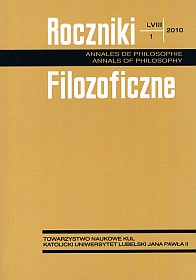The Experimental Test of General Theory of Relativity
Abstract
Space-based experiments in fundamental physics are presently capable of uniquely addressing important questions related to the fundamental laws of nature. In this article we discuss the advances in our understanding of fundamental physics that recently proposed space-based gravitational experiment such as Gravity Probe B Space Research Mission. Gravity Probe B is a satellite that will check two predictions of the general theory of relativity: the geodetic effect and so-called frame-dragging or Lense-Thirring effect. The purpose of this article is to describe the results that have been obtained in Gravity Probe B mission from the point of view of the history and philosophy of science. This article discusses also a problem of the financial challenges for the GP-B team.
References
Ahmedov B.J.: General relativistic galvano-gravitomagnetic effect in current carrying conductors, „Physics Letters” A 256 (1999), s. 9-14.
Bencze W.J., Eglington M.E., Brumley R.W., Buchman S.: Precision electrostatic suspension system for the Gravity Probe B relativity mission’s science gyroscopes, „Advances in Space Research” 39/2 (2007), s. 224-229.
Coles P.: Einstein and the Birth of Big Science, Cambridge: Icon Books 2000.
Ciufolini I.: On a new method to measure the gravitomagnetic field using two orbiting satellites, „Il Nuovo Cimento A’’ 109 (1996), s. 1709-1720.
Deligeorges S.: Foucault et ses pendules, Paris: Éditions Carré 1990.
Embacher F.: Mach, Thirring & Lense, Gödel – getting dizzy in space-time, „Journal of Physics: Conference Series” 82 (2007), s. 1-6 .
Everitt C.W.F.: James Clerk Maxwell: Physicist and Natural Philosopher, New York: Charles Scribner’s Sons 1975.
Everitt C.W.F.: Maxwell’s Scientific Papers, „Applied Optics” 6 (1967), s. 639.
Galison P.: Dlaczego magnetyzm żelaznej sztabki absorbował Einsteina bardziej niż praca nad ogólną teoria względności?, „Świat Nauki” 10 (2004), s. 46-49.
Gavroglou K.: Fritz London: a scientific biography, Cambridge: Cambridge University Press 1995.
Hughes T.P., Elmer Sperry: Inventor and Engineer, Baltimore: Johns Hopkins University Press 1971.
Iorio L.: Recent Attempts to Measure the General Relativistic Lense–Thirring Effect with Natural and Artificial Bodies in the Solar System, „Proceedings of Science” 017 (2009), s. 1-31.
Johnson P.: Modern Times Revised Edition: The World from the Twenties to the Nineties, New York: Harper Collins Publishers Inc. 2001.
Lawrance A.: Modern Inertial Technology. Navigations, Guidance, and Controle, New York: Springer Verlag 19982.
Lense J.: Thirring, H., Über den Einfluss der Eigenrotation der Zentralkörper auf die Bewegung der Planeten und Monde nach der Einsteinschen Gravitationstheorie, „Physikalische Zeitschrift” 19 (1918), s. 156-163.
Lew J.: Sto wcieleń żyroskopu, Warszawa: Wydawnictw MON 1963.
Lipa J.A., Everitt C.W.F.: The role of cryogenics in the gyroscope experiment, „Acta Astronautica” 5 (1978), s. 119-123.
London F.: Superfluids, vol. 1, New York: Wiley and Sons 1950; vol. 2, New York: Wiley and Sons 1954.
London F., London H.: The electromagnetic equations of the supraconductor, „Proceedings of the Royal Society”. A Mathematical, Physical and Engineering Sciences 149 (1935), s. 71-88,
Oktaba W.: Historia teorii eksperymentu, Lublin: LTN 2002.
Maxwell on Heat and Statistical Mechanics, ed. E. Garber, S.G. Brush, C.W.F. Everitt, London: Associated University Press 1995.
Maxwell on Saturn’s Rings, ed. S.G. Brush, C.W.F. Everitt, E. Garber, MIT Press 1983.
Pike B.: Illustrated Descriptive Catalogue of Optical, Mathematical and Philosophical Instruments: “Bohnenberger’s Machine”, vol.1, New-York 1848.
Schiff L.: Possible new experimental test of general relativity theory, „Physical Review Letters” 4 (1960), s. 215-217.
Schiff L.: Motion of a Gyroscope According to Einstein’s Theory of Gravitation, W: Nonlinear Gravitodynamics, The Lense-Thirring Effect, A documentary introduction to current research, ed. J. Ruffini, Costantino 1960, s. 427-438.
Schuler M.: Die Störung von Pendel und Kreiselapparaten durch die Beschleunigung des Fahrzeuges, „Physikalische Zeitschrift” 24 (1923), s. 16.
Stuewer R.H.: Physicist-Historians [w:] Positioning the History of Science, ed. K. Gavroglu, J. Renn, Dordrecht: Springer 2007, s. 169-172.
Thirring H.: Über die Wirkung rotierender ferner Massen in der Einsteinschen Gravitationstheorie, „Physikalische Zeitschrift” 19 (1918), s. 33.
Thirring H.: Berichtigung zu meiner Arbeit: „Über die Wirkung rotierender Massen in der Einsteinschen Gravitationstheorie”, „Physikalische Zeitschrift” 22 (1921): 29.
Vessot R.F.C. [et al.]: Test of Relativistic Gravitation with a Space-Borne Hydrogen Maser, „Physical Review Letters” 45 (1980), s. 2081-2084.
Copyright (c) 2010 Roczniki Filozoficzne

This work is licensed under a Creative Commons Attribution-NonCommercial-NoDerivatives 4.0 International License.





